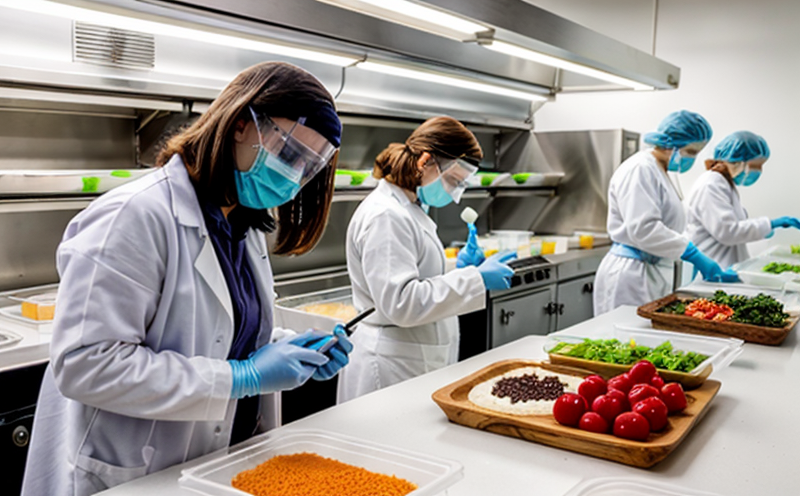AOAC 2013.02 Campylobacter spp. Rapid Detection Testing
The AOAC International standard method 2013.02 is widely recognized for its efficiency in detecting Campylobacter spp.—a pathogen that poses significant health risks to humans through contaminated food products such as poultry, raw milk, and water. This rapid detection test enables the early identification of contamination, which is crucial for maintaining high standards of hygiene and compliance with international regulations.
The method primarily targets Campylobacter jejuni and Campylobacter coli, two major species responsible for foodborne illnesses. These bacteria are known to cause severe gastrointestinal symptoms including diarrhea, abdominal cramps, fever, and nausea in consumers. In some cases, they can lead to more serious health issues like Guillain-Barré syndrome.
The AOAC 2013.02 method involves a combination of culture-based techniques with modern molecular diagnostic tools to achieve rapid results. It is specifically designed for the detection of Campylobacter spp. in raw and processed poultry products, but its applications extend beyond this scope. The test protocol includes steps such as sample preparation, inoculation into selective media, incubation conditions, and final confirmation through biochemical tests or PCR-based methods.
The importance of this method cannot be overstated. Food safety is paramount in the food industry, particularly when dealing with products that are known vectors for Campylobacter spp. contamination. By utilizing AOAC 2013.02, laboratories can ensure they meet stringent regulatory requirements and provide consumers with safe and wholesome food options.
This method is not only useful in the food processing industry but also plays a critical role in public health initiatives aimed at reducing the incidence of campylobacteriosis outbreaks. The rapidity and accuracy of this testing contribute significantly to quicker response times, allowing for more effective intervention measures to be implemented promptly.
The AOAC 2013.02 method is part of a broader suite of microbiological tests that help maintain food safety standards. It complements other methods like ATP bioluminescence and HACCP (Hazard Analysis and Critical Control Points) protocols, which together form the backbone of modern food safety management systems.
In summary, AOAC 2013.02 is a cornerstone in the battle against Campylobacter spp. contamination in the food sector. Its ability to provide rapid results makes it an indispensable tool for ensuring public health and regulatory compliance.
Why It Matters
The detection of Campylobacter spp. is critical because these bacteria are among the most common causes of foodborne illness worldwide. According to the World Health Organization (WHO), they account for a significant proportion of gastroenteritis cases globally, particularly in developing countries where hygienic practices may be less stringent than in developed regions.
The rapid and accurate detection provided by AOAC 2013.02 is essential because it allows food producers to identify contamination early, enabling them to take corrective actions before the product reaches consumers. This proactive approach not only mitigates health risks but also protects brand reputation and consumer trust.
- Reduces Health Risks: Early detection helps prevent the spread of illness among populations consuming contaminated food products.
- Enhances Product Safety: By ensuring that only safe products reach the market, this method supports overall product quality and safety standards.
- Safeguards Consumer Trust: Rapid and accurate testing instills confidence in consumers about the safety of purchased goods.
The importance of AOAC 2013.02 lies in its ability to contribute significantly to public health by providing reliable data that can inform regulatory decisions and improve food safety practices globally.
Benefits
- Rapid Results: AOAC 2013.02 provides quick detection, enabling timely interventions before contamination spreads.
- Improved Efficiency: The method streamlines the testing process, reducing downtime and increasing operational efficiency.
- Informed Decision-Making: Accurate results allow for better-informed decisions regarding product release and quality control measures.
- Consumer Confidence: By ensuring food safety, this test enhances consumer trust in brands and the broader industry.
The combination of speed, reliability, and comprehensive coverage makes AOAC 2013.02 an essential tool for maintaining high standards of food hygiene and compliance with international regulations.
Environmental and Sustainability Contributions
By ensuring that contaminated products are identified early, AOAC 2013.02 plays a crucial role in minimizing waste within the food industry. Early detection allows for corrective actions to be taken promptly, preventing potentially harmful products from reaching consumers. This not only protects public health but also reduces resource wastage and supports sustainable practices throughout the supply chain.
The method’s alignment with international standards further enhances its contribution to environmental sustainability by promoting harmonized testing protocols across borders. This ensures that food safety measures are consistent globally, thereby reducing inconsistencies and inefficiencies in regulatory compliance.
Moreover, AOAC 2013.02 contributes to the overall goal of sustainable development by supporting industries that prioritize safe and healthy products. By adhering to stringent standards like this, companies can contribute positively to both environmental conservation efforts and public health initiatives.





